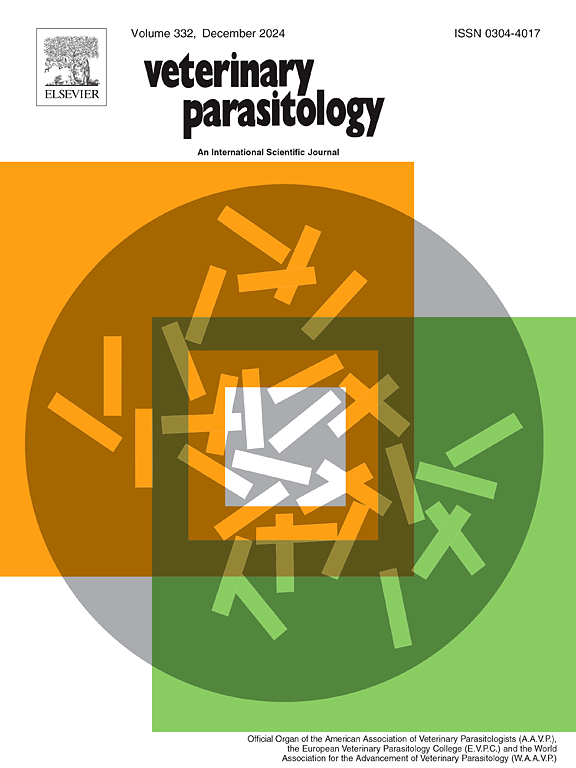一项关于土耳其锡尔特省绵羊、山羊和狗中普通棘球蚴的流行病学、诊断和特征的试点研究发现,山羊对罐头棘球蚴 (G6/G7) 有显著的适应性。
IF 2
2区 农林科学
Q2 PARASITOLOGY
引用次数: 0
摘要
由普通棘球蚴引起的囊性棘球蚴病(CE)是全球最重要的人畜共患病之一,对人类和动物都有影响。本研究旨在确定一个试点地区绵羊和山羊中普通棘球蚴的流行情况,并对屠宰场进行为期一年的跟踪调查,同时确定绵羊、山羊和狗分离株之间的遗传差异和单倍型。为此,在 2023 年期间,通过监测土耳其锡尔特省一家屠宰场每周至少三天的绵羊和山羊屠宰情况,确定了 CE 囊肿的流行情况。此外,还收集了流浪狗的粪便样本,并使用浮选和分子技术进行分析。在屠宰后的 5119 只绵羊和 2860 只山羊中,分别有 569 只(11.12%)和 66 只(2.31%)发现了 CE 囊肿。阳性率最高的是 11 月(20.39 %),最低的是 7 月(5.62 %)。在检测出阳性的绵羊中,25 只(4.39 %)不足一岁,544 只(95.61 %)超过一岁。在受感染的绵羊中,26 只(4.57 %)为雄性,543 只(95.43 %)为雌性。204只羊(35.85 %)表现为充满液体的CE囊肿,338只羊(59.40 %)表现为钙化,27只羊(4.75 %)表现为新形成的囊肿。山羊的阳性率最高为 12 月(5.83%),最低为 5 月(0.62%)。在阳性山羊中,有两只(3 %)不到一岁,其余 64 只(97 %)超过一岁。在感染 CE 囊肿的山羊中,10 只(15.15 %)为雄性,56 只(84.85 %)为雌性。在这些囊肿中,56.1%为充液囊肿,42.4%为钙化囊肿,1.5%为新发囊肿。对从屠宰场获得的 CE 囊肿分离物进行 DNA 序列分析后,61 个绵羊序列均被确定为肉毒梭状芽孢杆菌(G1/G3)。在13个山羊分离物中,7个被鉴定为E. granulosus s.s. (G1/G3),其余6个被归类为E. canadensis (G6/G7)。采用离心浮选法检测了 8 只狗体内的等孢子虫卵囊、3 只狗体内的犬弓形虫卵和钩虫卵,以及 1 只狗体内的犬双壳虫卵。共检查了 54 头狗的粪便。在所有狗的粪便中均未发现大肠杆菌卵。对狗粪便样本中的 mt-CO1 基因区进行 PCR 分析后发现,有四个样本的 875 bp 带呈阳性。其中只有一个条带适合进行序列分析,分析结果证实该条带为 E. granulosus s.s. (G1/G3)。本文章由计算机程序翻译,如有差异,请以英文原文为准。
A pilot study on the epidemiology, diagnosis and characterization of Echinococcus granulosus sensu lato in sheep, goats and dogs in Siirt province of Türkiye revealed remarkable adaptation of Echinococcus canadensis (G6/G7) in goats
Cystic echinococcosis (CE), caused by Echinococcus granulosus sensu lato (s.l.), represents one of the most significant zoonotic diseases globally, affecting both humans and animals. The objective of this study was to ascertain the prevalence of E. granulosus sensu lato in sheep and goats in a pilot region with a one-year slaughterhouse follow-up period and to determine the genetic differences and haplotypes among sheep, goat, and dog isolates. To this end, the prevalence of CE cysts was determined by monitoring the slaughter of sheep and goats at least three days a week at a slaughterhouse in the Siirt province of Türkiye during 2023. Additionally, faecal samples were collected from stray dogs and analysed using both flotation and molecular techniques. The presence of CE cysts was identified in 569 (11.12 %) of the 5119 sheep and 66 (2.31 %) of the 2860 goats after slaughtering. The highest positivity was observed in November (20.39 %), while the lowest was recorded in July (5.62 %). Of the sheep that detected positive, 25 (4.39 %) were less than one year old, while 544 (95.61 %) were older than one year. Of the infected sheep, 26 (4.57 %) were male and 543 (95.43 %) were female. 204 (35.85 %) sheep exhibited fluid-filled CE cysts, 338 (59.40 %) displayed calcification, and 27 (4.75 %) demonstrated the presence of newly developed cysts. The highest positivity was observed in December (5.83 %), while the lowest was recorded in May (0.62 %) in goats. Of the positive goats, two (3 %) were less than one year old, while the remaining 64 (97 %) were older than one year. Of the goats infected with CE cysts, 10 (15.15 %) were male and 56 (84.85 %) were female. Of the cysts, 56.1 % were fluid-filled, 42.4 % were calcified and 1.5 % were newly developed. Following DNA sequence analysis of CE cyst isolates obtained from the slaughterhouse, all 61 sheep sequences were identified as E. granulosus s.s. (G1/G3). Of the 13 goat isolates, seven were identified as E. granulosus s.s. (G1/G3), while the remaining six were classified as E. canadensis (G6/G7). The centrifugal flotation method was employed to detect the presence of Isospora spp. oocysts in eight dogs, Toxocara canis and hookworm eggs in three dogs each, and Dipyllidium caninum eggs in one dog. A total of 54 dog faeces were examined. No Taeniid eggs were observed in any of the dogs. Following PCR analysis of the mt-CO1 gene region in the dog faecal samples, four samples were positive for a 875 bp band. Only one of these bands was suitable for sequence analysis, which confirmed it as E. granulosus s.s. (G1/G3).
求助全文
通过发布文献求助,成功后即可免费获取论文全文。
去求助
来源期刊

Veterinary parasitology
农林科学-寄生虫学
CiteScore
5.30
自引率
7.70%
发文量
126
审稿时长
36 days
期刊介绍:
The journal Veterinary Parasitology has an open access mirror journal,Veterinary Parasitology: X, sharing the same aims and scope, editorial team, submission system and rigorous peer review.
This journal is concerned with those aspects of helminthology, protozoology and entomology which are of interest to animal health investigators, veterinary practitioners and others with a special interest in parasitology. Papers of the highest quality dealing with all aspects of disease prevention, pathology, treatment, epidemiology, and control of parasites in all domesticated animals, fall within the scope of the journal. Papers of geographically limited (local) interest which are not of interest to an international audience will not be accepted. Authors who submit papers based on local data will need to indicate why their paper is relevant to a broader readership.
Parasitological studies on laboratory animals fall within the scope of the journal only if they provide a reasonably close model of a disease of domestic animals. Additionally the journal will consider papers relating to wildlife species where they may act as disease reservoirs to domestic animals, or as a zoonotic reservoir. Case studies considered to be unique or of specific interest to the journal, will also be considered on occasions at the Editors'' discretion. Papers dealing exclusively with the taxonomy of parasites do not fall within the scope of the journal.
 求助内容:
求助内容: 应助结果提醒方式:
应助结果提醒方式:


